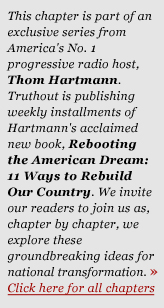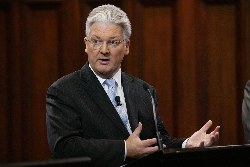Thom Hartmann: Roll Back the Reagan Tax Cuts
Roll Back the Reagan Tax
Cuts
by: Thom Hartmann,
Berrett-Koehler Publishers | Book
Excerpt

This is the third installment of Tom Hartmann's groundbreaking book, "Rebooting the American Dream: 11 Ways to Rebuild Our Country." (Image: Berrett-Koehler Publishers; Edited: to)
You must pay the price if you wish to secure the blessings.
- Andrew Jackson
When I was in Denmark in 2008 doing my radio show for a week from the Danish Radio studios and interviewing many of that nation’s leading politicians, economists, energy experts, and newspaper publishers, one of my guests made a comment that dropped the scales from my eyes.1
We’d been discussing taxes on the air and the fact that Denmark has an average 52 percent income-tax rate. I asked him why people didn’t revolt at such high taxes, and he smiled and pointed out to me that the average Dane is very well paid, with a minimum wage that equals roughly $18 per hour. Moreover, what Danes get for their taxes (that we don’t) is a free college education and free health care, not to mention four weeks of paid vacation each year and notoriety as the happiest nation on earth, according to a major study done by the University of Leicester in the United Kingdom.2
 But it was once we
were off the air that he made the comment that I found so
enlightening.
But it was once we
were off the air that he made the comment that I found so
enlightening.
“You Americans are such suckers,” he said. “You think that the rules for taxes that apply to rich people also apply to working people, but they don’t. When working peoples’ taxes go up, their pay goes up. When their taxes go down, their pay goes down. It may take a year or two or three to all even out, but it always works this way—look at any country in Europe. And that rule on taxes is the opposite of how it works for rich people!”
My Danish guest was right. So before we get into the larger consequences of tax increases or tax cuts for the nation’s economic health, let’s parse this business about what tax increases or cuts mean for the rich and for the not-so-rich.
Unequal Taxation and the Conservative Spin
If a wealthy person earns so much money that he doesn’t or can’t spend it all each year, when his taxes go down his income after taxes goes up. This is largely because there’s little or no relationship between what he “needs to live on” and what he’s “earning.” Somebody living on $1 million per year but earning $5 million after taxes can sock away $4 million in a Swiss bank. If his taxes go up enough to drop his after-tax income to only $3 million per year, he’s still living on $1 million per year and socks away only $2 million in the Swiss bank. Although his lifestyle doesn’t change, his discretionary income—some call it “disposable” income—goes down when his taxes go up and vice versa.
Most working Americans believe that their taxes and income work in the same way—something the right-wing think tanks and media want everyone to believe. So average Americans tend to support tax cuts because they think they’ll have more money in the bank as a result, but if their taxes go up, they’ll have less money in the bank. It’s pretty intuitive, and over the short term, it’s true.
But it never plays out that way. Our own experience—and the experience of the Danes and other Europeans—shows a completely different trend.
Unlike the rich, most working people spend pretty much all of what they earn—their discretionary income is extremely limited and in many cases zero. Savings rates in the United States among working people typically are small—1 to 5 percent. So the take-home pay that people have after taxes—regardless of what the tax rate may be—is pretty much what they live on.
As economist David Ricardo pointed out in 1817 in the “On Wages” chapter of his book On the Principles of Political Economy and Taxation, take-home pay is also generally what a person will work for. Employers know this: Ricardo’s “Iron Law of Wages” is rooted in the notion that there is a “market” for labor, driven in part by supply and demand.
So, if a worker is earning, for example, a gross salary of $75,000, his 2009 federal income tax would have been about $18,000, leaving him a take-home pay of $57,000. Both he and his employer know that he’ll do the job for that $57,000 take-home pay.
So let’s take a look at what happens if the government raises income taxes. For our average $75,000-per-year worker, his takehome pay might decrease from $57,000 to $52,000. So, in the short run, increased taxes have an immediate negative effect on him.
But here comes the part the conservatives don’t like to talk about. Our own history shows that within a short time—usually between one and three years—that same worker’s wages will increase enough to more than compensate for his lost income. Former Federal Reserve Chairman Alan Greenspan used to be hysterical about this effect—he called it “wage inflation”—and the Wall Street Journal and other publications would often reference it. It’s one reason why as income taxes increasingly hit more and more working people in the United States between the 1950s and 1981, income itself steadily went up, too.
Similarly, when the government enacts a tax cut, workingclass people’s taxes go down; but sure enough, over time, their wages also go down so their inflation-adjusted take-home pay remains the same.
Consider all the “tax cuts” working people have gotten over the past 30 years, from Reagan, Clinton, and Bush Jr. In each case, within a year or two working people’s wages were the same or lower. On the other hand, when working-class people’s taxes went up, during the Truman, Eisenhower, Johnson, and Nixon administrations, their wages went up in the following years, too.
We’ve seen both happen over the past 80 years, over and over again.
When it comes to the rich, though, it is the “top marginal tax rate” that matters most. That marginal tax rate applies to each bracket, and for 2009 taxes it was as follows:
Annual Income Marginal Tax
Rate
Less than $8,350
10%
$8,350 to $33,950 15%
$33,950 to $82,250 25%
$82,250 to $171,550 28%
$171,550 to $372,950 33%
$372,950 and higher 35%
So what happens if that top marginal tax rate goes up from its current 35 percent to, for example, the 1980 rate of 70 percent?
For the more than 120 million American workers who don’t earn more than $372,950 annually, it won’t mean a thing. But for the tiny handful of millionaires and billionaires who have promoted the Great Tax Con, it will bite hard. And that’s why they spend millions to make average working people freak out about increases in the top tax rates.
Taxes as the Great Stabilizer
Beyond fairness, holding back the landed gentry that the Founders worried about—America had no billionaires in today’s money until after the Civil War, with John D. Rockefeller being our first—in and of itself is an important reason to increase the top marginal tax rate and to do so now.
Novelist Larry Beinhart was the first to bring this to my attention. He looked over the history of tax cuts and economic bubbles and found a clear relationship between the two. High top marginal tax rates—generally well above 60 percent—on rich people actually stabilize the economy, prevent economic bubbles from forming, prevent the subsequent economic crashes, and lead to steady and sustained economic growth as well as steady and sustained wage growth for working people.3
On the other hand, when top marginal rates drop below 50 percent, the opposite happens.
As Beinhart noted, the massive Republican tax cuts of the 1920s (from 73 to 25 percent) led directly to the Roaring Twenties’ real estate and stock market bubbles, a temporary boom, and then the crash and Republican Great Depression that started in 1929.
Then, from the 1930s to
the 1980s, rates on the very rich went back up into the 70
to 90 percent range. As a result, the economy grew steadily,
and for the first time in the history of our nation we went
50 years without a crash or major bank failure. It was also
during this period that the American worker’s wages
increased enough to produce the strongest middle class this
nation has ever seen.
Then came Reaganomics.
Taking his cues from the conservative billionaires who fund right-wing think tanks like the Heritage Foundation, Reagan cut top marginal tax rates on the rich from 74 percent to 38 percent. Predictably, there was an immediate surge in the markets—followed by the worst crash since the Great Depression and the failure of virtually the entire nation’s savings-and-loan banking system.
Then came Bush Sr., running on his “no new taxes” pledge, who cut taxes once in office; the nation fell into a severe recession while debt soared and wages for working people fell.
During the Bill Clinton era, things stabilized somewhat when he slightly raised taxes on the very rich, but he was followed by Bush Jr., who cut them again, including cutting taxes on unearned income—interest and dividends that people like W, who are born with a trust fund, “earn” as they sit around the pool waiting for the dividend check to arrive in the mail—down to a top rate of 15 percent. That’s right, trust fund babies like Bush (and hedge fund billionaires) pay a maximum 15 percent federal income tax on their dividend and capital gains income, thanks to the second Bush tax cut.
The result of
this surge in easy money for the wealthy, combined with
deregulation in the financial markets, was the “froth”
Greenspan worried about that led us straight into the Second
Republican Great Depression in 2008.
The math is pretty
simple. When the über-rich are heavily taxed, economies
prosper and wages for working people steadily rise. When
taxes for the rich are cut, working people suffer and
economies turn into casinos.
How They Did It
So why is it that Americans have come to believe that tax cuts are good for everyone? The answer is that for decades now the überrich have relentlessly spent money to make Americans believe that lower taxes are the answer to all of America’s problems. They’ve done this partly through the media they own and partly through funding “think tanks” that legitimize their Great Tax Con.
Richard Mellon Scaife, a Pittsburgh native and heir to the Mellon family businesses, is a conservative billionaire who carries the title of publisher of the Pittsburgh Tribune-Review, the second-fiddle newspaper to that city’s larger daily, the Pittsburgh Post-Gazette. Although daily newspapers generally have not been faring well lately, Scaife’s Tribune-Review is a ridiculously expensive enterprise, given its paltry circulation of 50,000.
According to a 2007 report in the Post-Gazette, based on Scaife’s divorce filings, his ex-wife contended that the Tribune-Review “should be considered a hobby or personal cause rather than a business investment because the paper has lost $20 million to $30 million annually since it began publishing in 1992.”4
His ex-wife had it right—the newspaper is a “personal cause” for Scaife.
If you do the math, you come up with more than $300 million that Scaife has lost on the newspaper. The Internal Revenue Service (IRS) considers an activity a business (instead of a hobby) if there is “a reasonable expectation” of earning a profit and if it makes a profit in at least three of the past five years (although they’ve never gone after Scaife on this; as Leona Helmsley famously said, “Only the little people pay taxes”).
Scaife is not alone among billionaires flushing money down such news operations. As my friend and colleague Cenk Uygur of The Young Turks pointed out in a Daily Kos diary in July 2009, billionaire Rupert Murdoch loses $50 million per year on the New York Post, billionaire Philip Anschutz loses around $5 million per year on the Weekly Standard, and billionaire Sun Myung Moon has lost $2 to $3 billion on the Washington Times.5
So why are these guys willing to lose so much money funding conservative media? Why do they bulk-buy every right-wing book that comes out to push it to the top of the bestseller list and then give away the copies to “subscribers” to their Web sites and publications? Why do they fund to the tune of hundreds of millions of dollars per year right-wing think tanks and training programs and lobbying organizations?
The answer is pretty straightforward: they do it because it buys them respectability and gets their con job out there. And one of their most important goals is lower taxes—for millionaires and billionaires like themselves.
Scaife, for instance, has used the various family foundations he oversees to fund conservative causes over the years to the tune of hundreds of millions of dollars, including more than $20 million to just the Heritage Foundation. All you have to do to see how influential Heritage has been is to read its own propaganda. When President Reagan took office in 1981, Heritage dropped a 1,100-page tome titled Mandate for Leadership on his desk, which he promptly handed out to his entire cabinet. Among its achievements over the years, Heritage lists this under 1981:
A tax cut revolution.
Heritage’s Mandate for Leadership called for “An across-theboard reduction in marginal personal income tax rates in each bracket of about 10 percent in 1981, with similar rate reductions in 1982 and 1983.” The Reagan administration not only followed Mandate’s lead, but it appointed Heritage’s Norman Ture, the Mandate author who penned the chapter on tax policy, as treasury secretary for tax and economic affairs—a new position suggested by Mandate. The tax cut that eventually passed—a marginal rate reduction of 25 percent over three years—wiped out America’s economic “malaise,” producing the biggest economic boom in U.S. history.6
This conveniently ignores the fact that the tax cuts also resulted in the tripling of the federal deficit during the Reagan years, among other things. In January 2005, Heritage issued a much shorter, 156-page Mandate for Leadership and had this to say about it:7
The original version, published in 1980, was written for a new administration just gaining widespread support for its ideas. Dubbed the “bible” of the Reagan White House by the Washington Post, it provided a step-by-step guide to how to transform conservative principles into government policy.
“Today, those principles are well established in Washington, well accepted by American voters and well understood everywhere in terms of how they translate into policy,” [President Edwin] Feulner said.
Heritage is but one example of the ways that the rich succeed in influencing public policy, especially tax policy. One hears a constant drumbeat emanating from Heritage and other conservative think tanks to keep taxes low. And the conservative media that these same funders—billionaires like Scaife, Murdoch, Anschutz—own and finance are echoing those messages.
Even though William Kristol’s publication, the Weekly Standard, is a money-losing joke (with only 85,000 subscribers), his association with the publication is enough to get him on TV talk shows whenever he wants and even a column with the New York Times for a year. Similarly, the money-losing Washington Times catapulted Tony Blankley to TV stardom. And of course, Murdoch’s Fox “News” blares the anti-income-tax message 24/7.
One way in which the think tanks and the conservative media con the American public is to conflate income taxes for the rich with income taxes for everyone else. And this is the crux of the con job. When Bill Clinton proposed tax increases in 1993, think tanks like Heritage and Cato immediately opposed them with their myths about the negative consequences of tax increases. Here’s what a Heritage “analyst” wrote then:8
Proponents of raising taxes argue that the federal budget cannot be balanced without a tax hike. They argue, too, that tax increases will make the tax code fairer. Some even claim that tax increases will encourage economic growth by reducing the need for federal borrowing.
Raising taxes, however, would be a political and economic mistake, regardless of who pays and what taxes are increased. If history is any guide, higher taxes will fuel additional federal spending....
Higher taxes will shrink the tax base and reduce tax revenues.... In each case, proponents of the hike claimed that the deficit would decline. But in each case, the deficit rose the following year.
That “analysis” failed to point out that the federal budget has pretty much grown every year since the founding of the republic and that between the growth of both our population and our economy, and the effect of inflation, government expenditures go up every year regardless of tax policy.
Weeks later the Cato Institute, also funded heavily by wealthy right-wing supporters, echoed the opposition to the Clinton tax increases in a piece by Bruce Bartlett, titled “The Futility of Raising Tax Rates,” making a special effort to connect taxes for the rich with taxes for everyone else:9
The Clinton plan, therefore, is based on false premises and is unlikely to achieve the goal of increasing the tax burden on the wealthy. It will probably lead, instead, to higher taxes on the poor and the middle class, as higher revenues from the rich fail to materialize. In the end, the burden of higher taxes must fall largely on the middle class because that is where the bulk of income is. Thus, maintaining a low top tax rate is the best way to ensure that tax rates remain reasonable for those with low and moderate incomes.
These anti-tax messages have been delivered by clever language crafted by right-wing message experts like Frank Luntz and others so that terms like tax relief and tax burden have become household words. In the end, low tax rates, as we saw earlier, only keep the superwealthy—Moon and Murdoch and Scaife and Anschutz (and others)—richer than you or I could ever even imagine being. For these rich right-wing funders, the cash spent on money-losing media enterprises really is a “personal cause”—an investment that pays back by saving them millions in taxes each year.
It’s time we roll back the Reagan tax cuts that slashed the top 74 percent rate on millionaires and billionaires down into the low 30s. Let’s increase the top marginal tax rate and eliminate stock options as a form of executive compensation. This will go a long way toward stabilizing our economy and improving wages for lowerand middle-income Americans.
Taxing the very rich (who use only a small percentage of their income to “buy” things, stashing most of it in Swiss bank accounts) also supports working people in getting decent wages. When income above $3 million per year (from all sources) is taxed at 74 percent, as it was from 1964 to 1983, or at 91 percent, as it was from 1931 to 1964, CEO pay tends to drop down to around 30 times the pay of a company’s most lowly paid employees (as it was in the United States from 1932 until the mid-1980s and as it is in virtually every other nation of the world with similarly high top marginal tax rates). Worker wages are healthy, and a landed gentry superwealth class doesn’t emerge to threaten democratic institutions and mess with politics in ways that purely advantage only themselves. In other words, roll back the Reagan tax cuts.
The Stock Option Problem
My radio show has a mission statement. We don’t say it on the air, as it sounds a bit pompous, but it’s the metric against which we measure our work: Saving the world, by awakening one person at a time. During the 1980s, when I was CEO of an advertising agency10 in Atlanta, our mission statement was to help people communicate, to make better and more open companies. Before that, in 1983, I started a travel company11 that hit the front page of the Wall Street Journal the next year and has conducted around a quarter billion dollars in business since then, and its mission statement was to help people better understand the world by traveling through it. And in 1978 my wife and I started a community for abused children12 in New Hampshire, with a clear mission statement: Saving the world, one child at a time.
For most of American history, businesses—for-profit and nonprofit—had mission statements that were broader than simply serving the interests of shareholders and CEOs and referred instead to the long-term interests of the company, its workers, and its customers.
Economics author Barry C. Lynn noted that “by the 1950s managers were wont to present themselves as ‘corporate stewards’ whose job was to serve ‘stockholders, employees, customers, and the public at large.”13 In other words, besides the stockholders, there are also the workers, the customers, and the general public, who are crucial to the long-term well-being of the corporation itself. CEOs actually rose through the ranks of the business and felt loyal to the companies they ran. They’d often started in the mailroom as a 20-year-old and fully expected to retire with a comfortable pension, the company in the good hands of one of their younger protégé vice presidents, who was working his or her way to that CEO status.
That corporate mentality and mission was generally true all the way until the 1980s. But in the early Reagan years, something changed dramatically, and it’s devastated the American corporate landscape.
First, President Reagan effectively stopped enforcing the Sherman Antitrust Act of 1890, a law that effectively prevented cartels and monopolies and large corporations from dominating the markets. The Reagan administration’s backing off from enforcement of the act led to an explosion of mergers and acquisitions, buy-outs, greenmail, forced mergers, and other aggregations of previously competitive or totally unrelated companies. The big got bigger, the midsized got acquired or crushed, and the space in which small entrepreneurs could start and flourish nearly vanished.
But what followed this was even worse. Starting back in the 1930s, a particularly toxic form of economic thinking—some would argue sociopathic economic thinking—began to take hold, some of it propelled by theories developed at the Chicago School of Economics by Milton Friedman (who would later serve as an economic adviser to Reagan). By the 1980s that economic thinking had undergone several mutations, and the one that has hit America the hardest is the notion that every business in the nation has a single mission statement: maximize shareholder value and dividends.
The theory behind this was that in a modern corporation the role of the CEO and the executive-level workers is to do whatever is best for the shareholders.
To provide the incentive to CEOs and senior executives to “think like a shareholder,” tax and accounting rules were both changed and used in the 1980s to actually turn CEOs into more shareholder than employee. This was done by moving huge chunks of their compensation from payroll (cash) into stocks and stock options (the right to buy stock in the future at current prices and then quickly sell it for a profit). Although a CEO like Stephen J. Hemsley of UnitedHealth Group made an annual salary of $13.2 million in 2007, and $3.2 million in 2009 (a year when CEO pay in the health-care industry was under a lot of scrutiny), he was awarded more than $744 million worth of stock options during the few years he was CEO. His predecessor, William “Dollar Bill” McGuire, was paid more than $1.7 billion in stock options for his previous decade of work as CEO.14
Such compensation packages are now relatively common across corporate America, having created a new CEO aristocracy as well as a totally different business climate from the way America was before Reagan.
Besides the fact that such stock option deals are extremely lucrative for these executives without making their salaries seem sky high, they have another somewhat insidious effect. Because CEOs are now first and foremost stockholders, every decision is grounded in and colored by the question Will it immediately increase the price of my stock and the amount of the dividend income it pays?
Left in the dust are questions like What is best for this company’s long-term survival? and What is best for the communities in which we do business? Stock values are best increased by ruthlessly slashing costs (cutting employees, outsourcing to cheap-labor countries, and cutting corners in production) and increasing revenues (buying up competitors to create monopoly markets so price competition is minimized).
What’s more, the money these CEOs and executives make from the sale of the stocks they own or from the dividends those stocks pay is subject to an income tax of only 15 percent (as opposed to the 35 percent top marginal tax rate), the result of the Bush tax cuts. No wonder the rich are getting richer, the jobs are going abroad, and average workers are just plain old out of luck.
Shrink the Government by Raising Taxes
From 1985 until 2008, William A. Niskanen was the chairman of the Cato Institute, a libertarian think tank, and before 1985 he was chairman of Reagan’s Council of Economic Advisers and a key architect of Reaganomics. He figured out something that would explode Reagan’s head if he were still around. Looking at the 24-year period from 1981 to 2005, when the great experiment of cutting taxes (Reagan) then raising them (Bush Sr. and Clinton) then cutting them again (Bush Jr.) played out, Niskanen saw a clear trend: when taxes go up, government shrinks, and when taxes go down, government gets bigger.
Consider this: You have a clothing store and you offer a “50 percent off” sale on everything in the store. What happens? Sales go up. Do it for a few years and you’ll even need to hire more workers and move into a larger store because sales will continue to rise if you’re selling below cost. “But won’t the store go broke?” you may ask. Not if it’s able to borrow unlimited amounts of money and never—or at least not for 20 years or more—pay it back.
That’s what happens when we have unfunded tax cuts. Taxpayers get government services—from parks and schools to corporate welfare and crop subsidy payments—at a lower cost than they did before the tax cuts. And, like with anything else, lower cost translates into more demand.
This is why when Reagan cut taxes massively in the 1980s, he almost doubled the size of government: there was more demand for that “cheap government” because nobody was paying for it. And, of course, he ran up a massive debt in the process, but that was invisible because the Republican strategy, called “two Santa Clauses,” is to run up government debt when in office and spend the money to make the economy seem good, and then to scream about the debt and the deficit when Democrats come into office. So while Reagan and W were exploding our debt, there wasn’t a peep from the right or in the media; as soon as a Democrat was elected (Clinton and Obama), both the right-wingers and the corporate media became hysterical about the debt.
And when Clinton raised taxes so that people actually started paying the true cost of government (a balanced budget as in the years 1999 and 2000), they concluded that they didn’t need as many services, so government actually shrank—in terms of both cost and the number of federal employees.
Then Bush Jr. comes into office and goes back to Reaganomics and again cuts taxes and puts the cost on the national credit card, and, bingo, he presides over the largest increase in the size and the cost of government in the history of our republic.
The Reaganomics theory was that people would use less government when they saw the huge deficits that use of government during times of low taxes was racking up, but that’s not what happened. Instead, people and businesses ignored the deficit and went shopping for discounted government.
Running the numbers through a fine-toothed comb, Cato’s Niskanen was even able to determine the exact tipping point for taxes and demand for government services: 19 percent of GDP. Whenever taxes were above that point (FDR to Carter and during the Clinton years), government grew more slowly than the rest of the economy or even shrank. Whenever taxes were below 19 percent of GDP, government grew in size and spending (usually military but others as well) like a fat man at a pie-eating contest.
“I would like to be proven wrong,” Niskanen told Atlantic Monthly writer Jonathan Rauch. And Rauch noted, “The way to limit the growth of government is to force politicians, and therefore voters, to pay for all the government they use—not to give them a discount.” And that means raising taxes to a point above 19 percent of GDP. “Voters will not shrink Big Government until they feel the pinch of its true cost,” Rauch wrote.15
Of course this is very bad news for people who want to put Reagan’s picture on the $50 bill and reshape Roosevelt’s face into Reagan’s on Mount Rushmore, which is probably why the former chairman of Cato’s report on the issue is buried in an obscure part of its Web site and the only significant coverage his discovery ever got was Rauch’s article.
But it comports with both common sense and a generation of tax tables. Reagan and Bush Jr. cut taxes, leading to a bloated government and huge debts. Clinton increased taxes, which cut demand for (and thus the size of) government and let him begin to pay down the debt. If “conservatives” really want “small government,” they should be talking about putting the guy they call Slick Willy’s picture on the 50 instead of Ronnie’s.
Reverse and Roll Back
If we want to have long-term economic stability and if we want to have fairness in our tax policy, it is quite clear what we have to do. We have to first undo the damage done by the right-wing think tanks and media, funded by the Scaifes, the Murdochs, the Anschutzes, and the Moons, and get Americans to see taxes not as a burden but as both the admission price to civil society and investments in our nation’s future.
For too long the über-rich have spent hundreds of millions to make sure phrases like tax burden and tax relief have become embedded in the national consciousness, so today people have come to think of taxes as inherently bad. Based on that assumption, the über-rich have also convinced working people that they should throw out of office any politicians who are willing to raise taxes on the rich. (Because there were no right-wing think tanks at the time, Americans applauded rather than screamed about Woodrow Wilson’s and Herbert Hoover’s raising taxes on rich people above 80 percent.)
So we have to help Americans realize that “no new taxes” is a mantra that is meaningful to the very rich but largely hurts average working people.
Only when the current generation relearns the economic and tax lessons well known by the generation (now dying off) that came of age in the 1930s through the 1960s will this become politically possible. Americans need to learn what Europeans know about income taxes—that they really matter only to the rich.
We need to remind people that it was not that long ago when we had the rich paying top marginal tax rates of 70 percent (at the start of the Reagan years); and if we want to go further back, we used to have top marginal tax rates above 90 percent in the Eisenhower years. Our current tax rates and the antitax fever are the result of relentless right-wing propaganda that began during the so-called Reagan revolution and has continued ever since.
If we really want our country to recover its financial footing, we must roll back the Reagan tax cuts that took the top marginal rate from above 70 percent down into the 30 percent range. To stop the “casino economy” that always emerges when the very highest-income people are allowed to keep whatever they can get, regardless of how they got it (so long as it’s legal), there has to be a collective notion of “how rich is too rich for society to afford” and income above that rate is taxed at the old 70 to 90 percent rate.
In addition to rolling back the Reagan tax cuts so that millionaires and billionaires have little incentive to plunder their companies and slash (or export) their workforces, we must also ban the use of stock options as a form of compensation for top corporate executives. This will shift the focus of CEOs and senior managers from stock price and dividends (a focus that has destroyed numerous companies, from Enron to Lehman Brothers to BP) to the long-term health of the company itself.
If we want to keep the stock options as compensation, we must at the least tax those stock options at the same top marginal tax rates as the salaries of the rich by considering capital gains as ordinary income.
We have a lot of educating to do. And so long as the rightwing machine of the über-rich continues to “lose” (i.e., “invest”) millions of dollars a year in their ongoing disinformation campaign, it’s going to require all of us reciting the mantra: “Roll back the Reagan tax cuts!”
1. This story was first noted in ThomHartmann, Threshold: The Crisis of Western Culture (New York: Viking, 2009).
2. “University of Leicester Produces the First Ever World Map of Happiness,” news release, July 29, 2006, http://www2.le.ac.uk/ ebulletin/news/press-releases/2000-2009/2006/07/nparticle .2006-07-28.2448323827.
3. Larry Beinhart, “Tax Cuts: Theology, Facts & Totally F**ked,” Huffington Post, November 17, 2008, http://www.huffingtonpost .com/larry-beinhart/tax-cuts-theology-facts-t_b_144281.html.
4. Pittsburgh Post-Gazette, “Scaife Demands Documents from Post-Gazette,” September 23, 2007, http://www.post-gazette.com/ pg/07266/819835-85.stm#ixzz0kTL6k84B.
5. Cenk Uygur, “Conservative Media vs. Progressive Media,” Daily Kos, July 1, 2009, http://www.dailykos.com/story/2009/7/1/748854/ -Conservative-Media-vs.-Progressive-Media.
6. “The Heritage Foundation’s 35th Anniversary: A History of Achievements,” http://www.heritage.org/About/Our-History/ 35th-Anniversary.
7. “New ‘Mandate for Leadership’ Will Help Citizens Keep Politicians Honest,” news release, January 10, 2005, http://www.heritage.org/ Research/Reports/2005/01/New-MANDATE-FOR-LEADERSHIP -Will-Help-Citizens-Keep-Politicians-Honest.
8. “The
Impact of Higher Taxes: More Spending, Economic Stagnation,
Fewer Jobs, and Higher Deficits,” February 10, 1993, http://www
.heritage.org/Research/Reports/1993/02/The-Impact-of-Higher
Notes
207
-Taxes-More-Spending-Economic-Stagnation-Fewer-Jobs-and
-Higher-Deficits.
9. Bruce Bartlett, “The Futility of Raising Tax Rates,” Cato Policy Analysis No. 192, http://www.cato.org/pubs/pas/pa-192.html.
10Chandler, MacDonald, Stout, Schneiderman and Poe, Inc., dba The Newsletter Factory, http://www.nlf-pmr.com/html/about_us.html.
11. International Wholesale Travel, dba Sprayberry Travel, http://www .sprayberrytravel.com/about_company.htm.
12. The New England Salem Children’s Village, www.salemchildrens village.org.
13. Barry C. Lynn, “Abolish Stock Options,” Harpers, November 2008, http://harpers.org/media/pages/2008/11/pdf/HarpersMagazine -2008-11-0082251.pdf (requires subscription).
14. Peter Drier, “Meet UnitedHealth CEO Stephen Hemsley: Rich, Powerful, Not Yet Famous,” Huffington Post, October 6, 2009, http://www.huffingtonpost.com/peter-dreier/meet-unitedhealth -ceo-ste_b_310674.html.
15. William A. Niskanen, “Chairman’s Message: ‘Starve the Beast’ Does Not Work,” CATO Policy Report March/April 2004, http://www .cato.org/pubs/policy_report/v26n2/cpr-26n2-2.pdf; and Jonathan Rauch, “Stoking the Beast: Cutting Taxes to Shrink Government Doesn’t Work—and That Spells Trouble for the Conservative Movement,” Atlantic, June 2006, http://www.theatlantic.com/ magazine/archive/2006/06/stoking-the-beast/4862.
Thom Hartmann is a New York Times bestselling Project Censored Award winning author and host of a nationally syndicated progressive radio talk show. You can learn more about Thom Hartmann at his website and find out what stations broadcast his program. He is also now has a daily television program at RT Network. You can also listen to Thom over the Internet.
Copyright Berrett-Koehler Publishers. Truthout has obtained exclusive rights to reprint this content. It may not be reproduced, and is not covered by our Creative Commons license.
All republished content that appears on Truthout has been obtained by permission or license.
ENDS


 Peter Dunne: Luxon Gets Out His Butcher's Knife - Briefly
Peter Dunne: Luxon Gets Out His Butcher's Knife - Briefly Binoy Kampmark: Warring Against Encryption, Australia Is Coming For Your Communications
Binoy Kampmark: Warring Against Encryption, Australia Is Coming For Your Communications Gordon Campbell: On Fast Track Powers, Media Woes And The Tiktok Ban
Gordon Campbell: On Fast Track Powers, Media Woes And The Tiktok Ban Binoy Kampmark: Censorship Wars, Elon Musk, Safety Commissioners And Violent Content
Binoy Kampmark: Censorship Wars, Elon Musk, Safety Commissioners And Violent Content Gordon Campbell: On The Public Sector Carnage, And Misogyny As Terrorism
Gordon Campbell: On The Public Sector Carnage, And Misogyny As Terrorism Ramzy Baroud: NATO’s Never-ending War: The 75-Year-Old Bully Is Faltering
Ramzy Baroud: NATO’s Never-ending War: The 75-Year-Old Bully Is Faltering